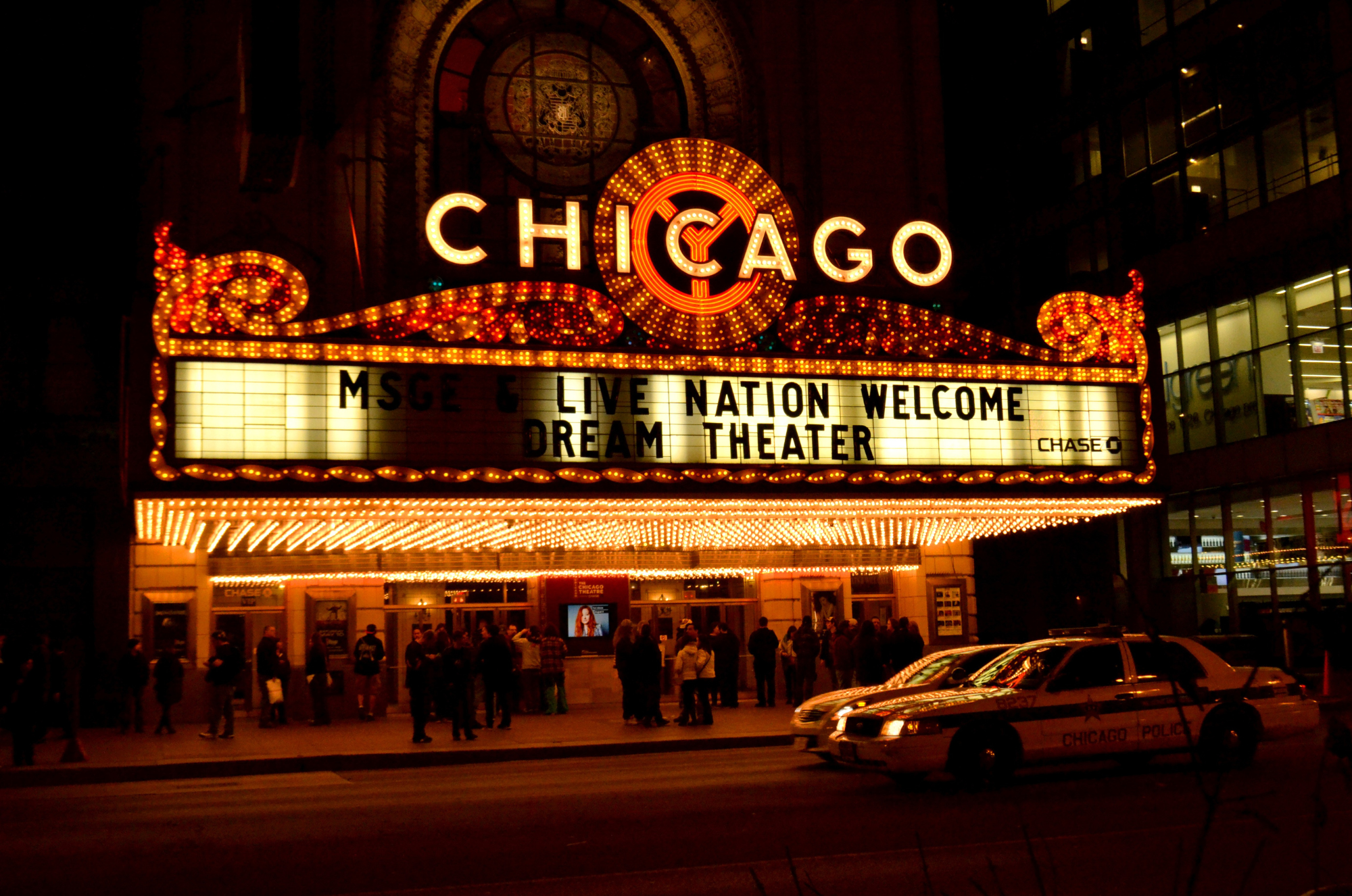
Iconic Chicago: The Chicago Theatre – wonder theatre of the world
Published on December 21, 2022
Our monthly series Iconic Chicago looks at some of the most famous locations in our city. We’ll explore the history of these places and why they have earned the love of residents and tourists alike. The latest installment of Iconic Chicago explores the Chicago Theatre, which is one stop on eATLAS’ walking tour of classic and modern neon signs found in the Loop.
Is it possible for one building to symbolize a century’s worth of a city’s history? If so, then no structure in the Windy City does it like the Chicago Theatre. For more than a century, the State St. landmark has mirrored the rise, decline, and rebirth of the city for which it is named.
The Chicago Theatre was Balaban & Katz’s fourth “movie palace.” Brothers Barney and A.J. Balaban were the children of Bessarabian Jewish immigrants who opened their first theater, a 100-seat nickelodeon, in 1909 on the Near West Side. That led to the Circle Theatre, which also had a pipe organ and a small orchestra to accommodate vaudeville acts performing between reels.
The brothers joined forces with another theater owner, Sam Katz, in 1915 and set their sights even higher. Two years later Katz married the Balabans’ sister and the new company opened their first two movie palaces, the Central Park in North Lawndale and the Riviera in Uptown. Both were collaborations with the architectural firm of Rapp and Rapp. A third, the Tivoli, opened in Woodlawn in February 1921. By this time, they were about ready to move to the Loop.
The Building of the Chicago Theatre
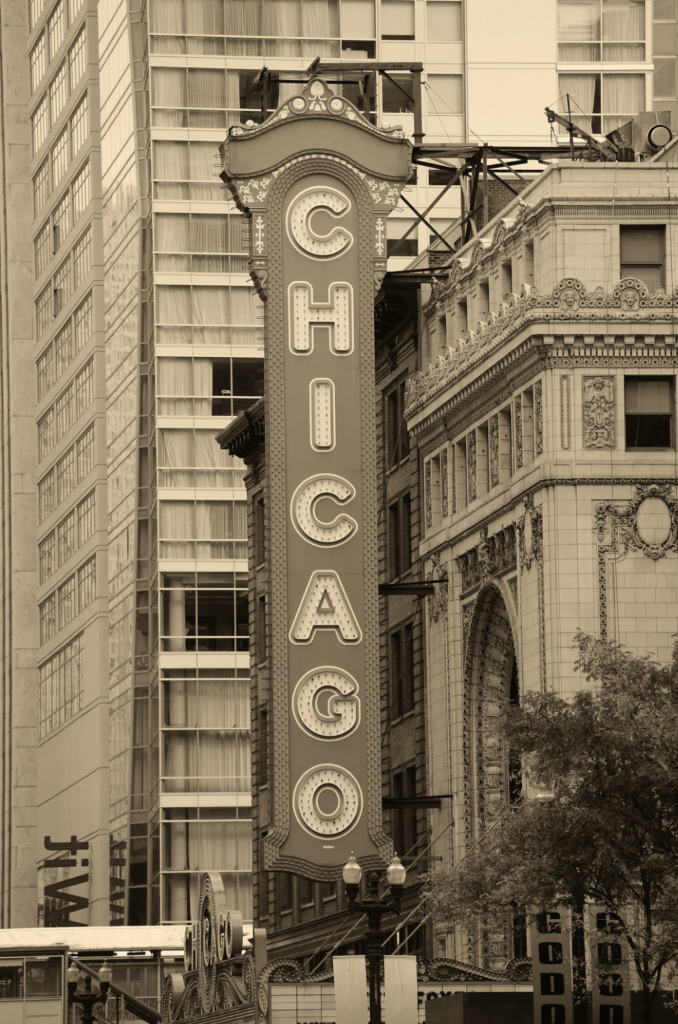
Built at a cost of $4 million, the Chicago Theater was arguably the most lavish of its kind in the world at the time, with 5,000 seats (2,600 on the floor, 500 in the mezzanine, and 1,900 in the balcony). Although it’s primarily thought of as a movie house, the theater was built with productions in mind. The stage—75’ wide x 30’ deep x 50’ high—was big enough to put on a grand opera, its orchestra pit could hold 60 musicians, and the lighting system was state-of-the-art. A $100,000 white, four-keyboard “Mighty Wurlitzer” organ—Opus 434—with 25 rows of pipes (later expanded to 29) was built to provide the music for silent films and stage shows. Balaban & Katz had even built a 250-seat miniature theater on the top floor, dubbed “Little Chicago,” to workshop productions intended for the big stage.
For the interior, Balaban & Katz and the Rapps looked to France for inspiration. The Grande Lobby was based on the Royal Chapel at Versailles, the staircase was inspired by the Paris Opera, and Louis XIV furniture graced the foyers. There was also a local flavor. All the lighting, from the bronze fixtures on the walls to the crystal chandeliers, were custom-made by the Chicago-based Victor Pearlman & Co., and the drapes and carpets came from Marshall Field’s just a block away. A bridge between the two worlds could be found in the auditorium’s French-themed murals, painted by local artist and professor Louis Grell.
A similar connection between old Europe and the modern Midwest was on the exterior. The Neo-Baroque French Revival building, clad in off-white terra cotta, resembles the Arc de Triomphe, whose influence was most evident at night thanks to the stud lighting. Below the arch sits a Tiffany stained glass piece with the Balaban & Katz coat of arms, two horses with ribbons of film in their mouths.
Hanging off the facade, off-center so as to not obstruct the arch, was Thomas Cusack’s 74-foot vertical sign. It consisted of more than 2,400 bulbs and “CHICAGO” in six-foot letters that blinked on and off, one letter at a time. In 1996, it was replaced with an aluminum replica with a modern electrical system made by Kieffer & Co. of Sheboygan, Wisconsin. Cusack’s original was donated to the Smithsonian. The original marquee, however, was a simple canopy with a two-line attraction board.
But there was one logistical issue specific to Chicago that needed to be addressed: to combat the noise and vibrations from the “L” trains, the wall facing Lake St. was doubled in thickness.
The Grand Opening
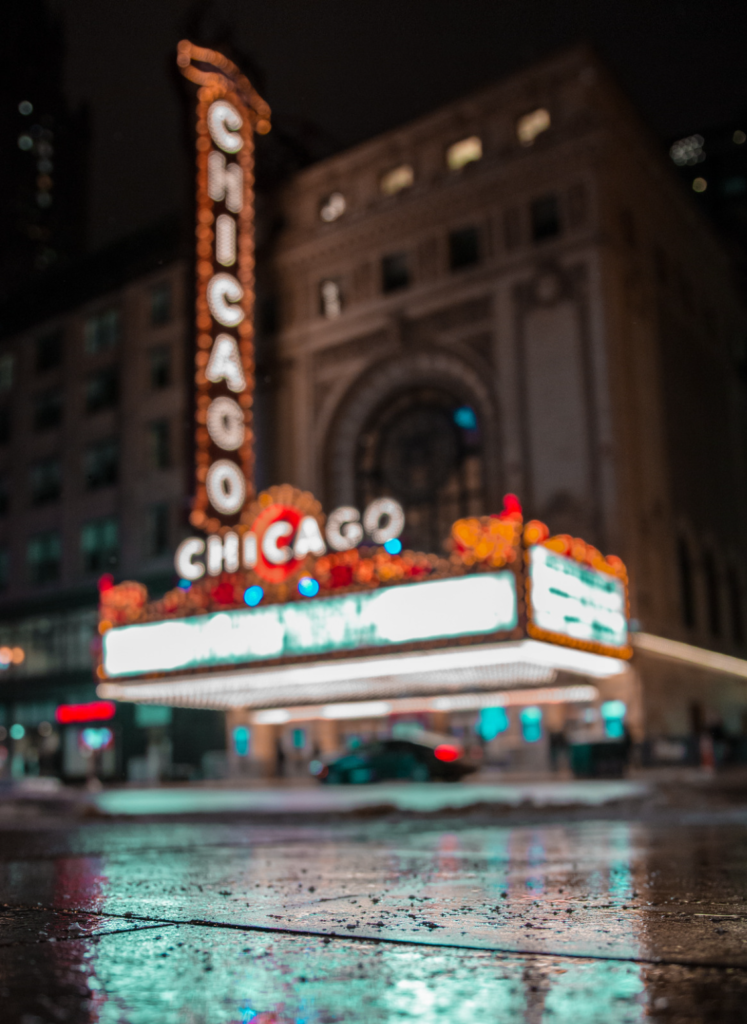
The Chicago Theatre was hyped as “The Wonder Theatre of the World” when it opened on Oct. 26, 1921. Visitors were treated to an overture provided by a 50-piece orchestra, a scene from Gounod’s opera Faust, an organ solo by Jesse Crawford, a Chicago-themed “musical pageant,” and two films: Buster Keaton’s two-reel comedy The Playhouse and The Sign on the Door, starring Norma Talmadge.
Within a year, Balaban & Katz began hosting jazz concerts at the theater, starting with “Syncopation Week” in September 1922. As Jazz Age Chicago notes, bringing jazz—performed by all-white dance bands—attracted well-heeled patrons who were more comfortable with the European opulence of the Chicago Theatre and reluctant to venture into jazz clubs in the city’s Black neighborhoods.
By 1923, the marquee that has come to define the Chicago Theatre was in place. Featuring colorful, flashing pinwheels and swirls and the city’s municipal device—a “Y” that represents the forking of the Chicago River—the marquee encapsulates the combination of glamour and fun that was Chicago during the Roaring Twenties.
Within a decade, the theater received its first renovation. To prepare for the 1933-34 World’s Fair, it was spruced up a bit, with a fresh coat of paint and new fabrics everywhere. Grell replaced his French murals with new depictions of Greek and Roman mythology.
The 1940s began and ended with changes to the theatre. The first was relatively minor, with the attraction boards on the sides of the marquee doubled and “CHICAGO” now only appearing on the front.
The second, which started in 1949 and took a year to complete, was far more consequential. The lobbies, foyers, and lounges were modernized and streamlined. Gone were the elegant French influences—the Louis XIV furniture, chandeliers, and marble flooring—replaced by basic pink vinyl benches with foam rubber cushions, brass-and-fiberglass sconces, and terrazzo or plastic Flexachrome tiles. False ceilings were installed to create a sense of intimacy. The lower promenade now resembled a New Orleans garden with wrought iron and red brick half-walls. Basically, everything that made the Chicago Theatre unique was gone.
A Slow Decline
The renovations coincided with a sea change that affected cities across America. As city dwellers migrated to the suburbs, businesses followed. Even if a newly constructed cinema couldn’t compete with the opulence of the Chicago Theatre, it was easier to get to than navigating through downtown Chicago. In 1957, due to rising costs, the theater stopped staging concerts and shows after a 35-year period that saw virtually all of the era’s major stars grace its stage, including Frank Sinatra, Bob Hope, Judy Garland, Cab Calloway, Milton Berle, Ethel Waters, and Benny Goodman.
After a series of mergers, acquisition, and spin-offs that began in 1926, the Balaban & Katz empire in 1969 was in the hands of ABC Theatres. In an effort to turn the Chicago Theatre’s fortunes around, the Wurlitzer was restored and, in 1973, the same year former ABC executive Henry Plitt formed his own company and bought all the Balaban & Katz properties, live performances returned to the Chicago Theatre. Around this time, the capacity was downgraded to 3,880 seats.
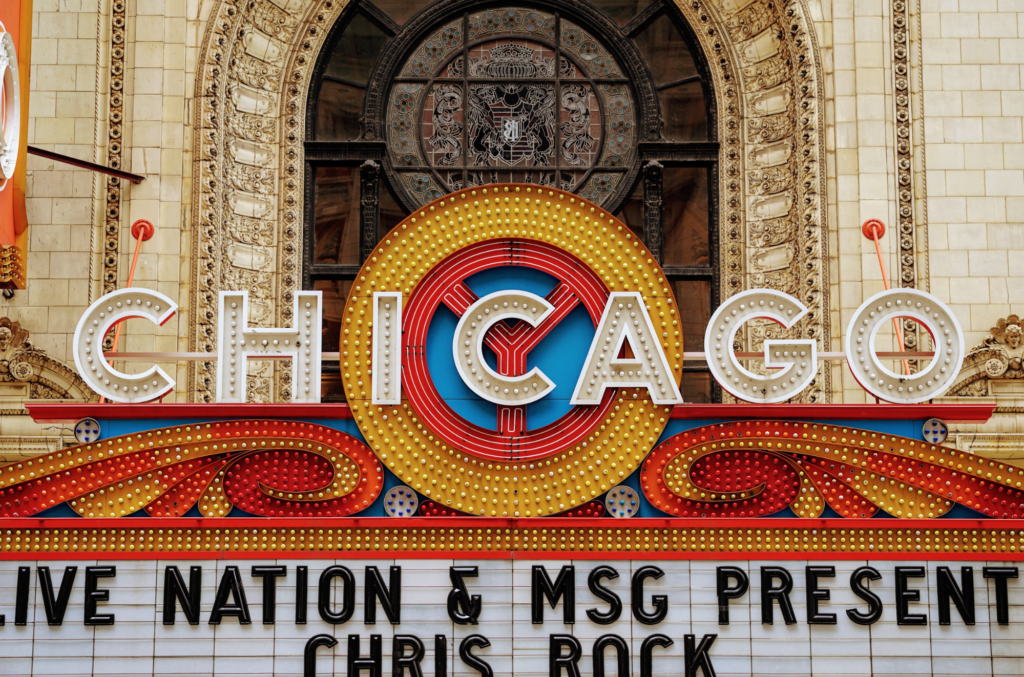
The Loop continued to decline throughout the 1970s. By the end of the decade the Chicago Theatre, which was added to the National Register of Historic Places in 1979, was in such a bad condition that a local joke reported there were more rats in the Chicago Theatre than patrons. Plitt wanted to demolish the theater and the adjacent Page Brothers Building and construct a high-rise office block in their place. The city denied the permit, with Mayor Jane Byrne claiming that they were essential to plans to revitalize the northern half of the Loop, and landmarked both buildings in 1983. Plitt sued, saying that the city should buy it for $32 million or let him do what he wanted with his buildings.
The fight continued for two years. On Sept. 19, 1985, following a double feature of American Ninja and Teen Wolf, the Chicago Theatre, once a symbol of the city’s grandeur, closed.
Enter the Preservationists and the Rebirth of the Chicago Theatre
As the battle for the building’s future raged, the city recruited Marshall Holleb, a prominent attorney. Holleb assembled about 140 citizens to form the Chicago Theatre Preservation Group. A month after the theater shuttered its doors, a deal was reached to purchase the Chicago Theatre and the Page Brothers Building for $11.575 million, $10 million of which came from the CTPG. The remainder of the funds, plus an extra $13.425 million were in the form of federal grant and loans to be used to restore the landmarks.
The CTPG hired architect Daniel P. Coffey to spearhead the project. They brought the theater back to the elegance and glory of the 1932-33 renovation while modernizing the facility for live performances. The marquee, which hadn’t been fully lit since 1956, was replaced with a replica of the 1923 version, albeit without “CHICAGO” on the sides. At a ceremony on Sept. 7, 1986, Mayor Harold Washington turned on the marquee for the first time in 40 years.
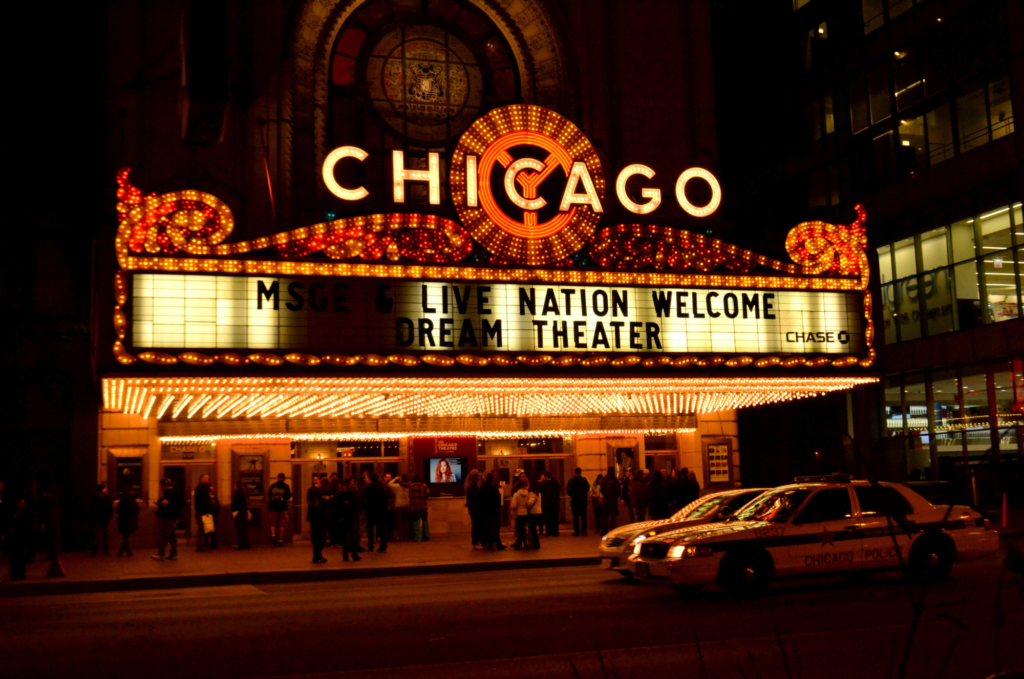
Three days later, the theater, whose capacity was now down to 3,600, officially reopened with a gala concert by Frank Sinatra. Ol’ Blue Eyes, whose last concert in the theater had been in 1946, opened his set with his ode to the city from his 1964 Rat-Pack-in-Prohibition-Chicago film Robin and the 7 Hoods, “My Kind of Town.” Sinatra’s residency lasted five days, after which he began a tradition that continues to this day with acts who play the Chicago Theatre: he signed a wall backstage. “Have a super time,” he wrote. “I just did!!!”
For all the press that the reopening generated, the theater still had trouble turning a profit. A series of owners and operators followed, including a three-year stint in the mid-‘90s by a subsidiary of the Walt Disney Co., who wanted to use it as a midwestern base for their musicals, only to discover that the stage couldn’t be expanded.
The New York-based MSG Entertainment, which also owns and operates Madison Square Garden and Radio City Music Hall, purchased the Chicago Theatre in 2008. Two years later, MSG Entertainment and JPMorgan Chase launched a marketing partnership that gave Chase sponsorship of the theater, with their logo on both the marquee and the vertical sign, although it did not grant Chase naming rights. The deal was renewed in 2021.
These days, multiplexes with all sorts of modern conveniences have replaced movie palaces as the way we view films on a ‘big screen’. But going inside the Chicago Theatre, or even just standing outside it and staring at the marquee (particularly at night), is a trip back to the days when going to the cinema was a reason to get dressed up and paint the town red.

The Adventure starts when you say it does.
All eATLAS Adventures are designed and built by experienced eATLAS Whoa!Guides. They're always on. Always entertaining. And always ready to go.
Check out our Adventures!